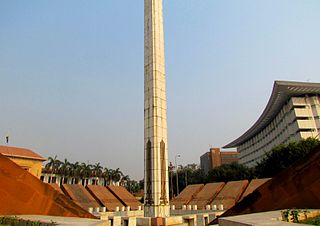 W
WAli Masjid is the narrowest point of the Khyber Pass. It is located in Khyber District of Khyber Pakhtunkhwa, Pakistan. It is located around 10 miles (16 km) east of the city of Landi Kotal and has an elevation of 3,174 feet (967 m). The width of the Khyber near Ali Masjid was earlier too narrow for two fully laden camels to pass each other but since has been widened.
 W
WThe Monument to Christ the King is a white marble structure in the grounds of Saint Patrick's Cathedral, Karachi, Pakistan.
 W
WThe Hindu and Buddhist architectural heritage of Pakistan is part of a long history of settlement and civilization in Pakistan. The Indus Valley civilization collapsed in the middle of the second millennium BCE and was followed by the Vedic Civilisation, which extended over much of northern India and Pakistan.
 W
WThe Islamic Summit Minar is an obelisk-shaped structure built in the centre of Charing Cross, Mall Road in the city of Lahore, Punjab the province of Pakistan. It was built to commemorate the second Islamic Summit Conference held in Lahore in 1974. Its foundation stone was laid on 22 February 1974 on the first anniversary of the conference. It is 155 feet (47 m) high.
 W
WKhaliq Dina Hall, also spelled Khaliq Deena Hall, is a library and hall located in Karachi, Pakistan. The building was built in 1906, and was after Ghulam Hoosain Khalikdina - a wealthy merchant and philanthropist who was the main financier for the building, and who wished for Karachi's Muslims to have a space for literary pursuits. It currently has a hall which is used for various events, a library, and a room that serves as the office of a local NGO.
 W
WAccording to Pakistan Environmental Protection Agency, as of October 1997, there are 9 National Monuments within the country. An additional monument, Pakistan Monument was built in the capital, Islamabad, during the 2000s. There are four monuments in Sindh, four in Punjab, and only one in Balochistan.
 W
WMinar-e-Pakistan is a national monument located in Lahore, Pakistan. The tower was built between 1960 and 1968 on the site where the All-India Muslim League passed the Lahore Resolution on 23 March 1940 - the first official call for a separate and independent homeland for the Muslims of British India, as espoused by the two-nation theory. The resolution eventually helped lead to the emergence of an independent Pakistani state in 1947.
 W
WNicholson's Obelisk, or 'Nicholson's Memorial', is a monument in Pakistan, erected in 1868 in honour of Brigadier-General John Nicholson, a famous military figure of the British Empire.
 W
WThe Pakistan Monument is a national monument and heritage museum located on the western Shakarparian Hills in Islamabad, Pakistan. The monument was constructed to symbolize the unity of the Pakistani people. It is dedicated to the people of Pakistan who sacrificed their "today" for a better "tomorrow". Its elevation makes the monument visible from across the Islamabad-Rawalpindi metropolitan area and is a popular tourist destination.
 W
WQuaid-e-Azam Residency, also known as Ziarat Residency, is located in Ziarat, Balochistan, Pakistan. It is where Quaid-e-Azam, Muhammad Ali Jinnah spent the last two months and ten days of his life, nursed by A. S. Nathaniel. It is the most famous landmark of the city, constructed in 1892 during the British Raj. The building is a wooden structure, originally designed as a sanatorium before being converted into the summer residence of the agent of the Governor General. It is declared a heritage site and is of great architectural importance.